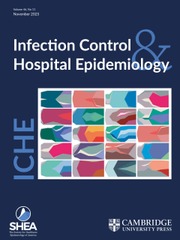Article contents
Creating an Outpatient-Specific Antibiogram to Guide Treatment for Urinary Tract Infections
Published online by Cambridge University Press: 02 November 2020
Abstract
Background: Outpatients with uncomplicated urinary tract infections (UTIs) are often treated empirically without culture, whereas urine cultures are typically collected from patients with complicated UTI. Susceptibilities for fosfomycin (a first-line agent) are not routinely performed or reported in the antibiogram. Understanding the prevalence of antibiotic resistance for UTI is critical for empiric treatment and antibiotic stewardship in primary care. Methods: We developed a UTI-focused antibiogram from a prospective sample of outpatients (women and men) with UTIs from 2 public family medicine clinics in an urban area with a diverse, international population (November 2018 to present). During the study period, providers ordered a urine culture for any adult patient presenting with UTI symptoms, including uncomplicated and complicated infections. We estimated the prevalence of resistance to UTI-relevant antibiotics in the overall study population and compared it between patients born in the United States and other countries. Results: We collected 678 urine cultures from 644 unique patients (79% female). Of these cultures, 158 (23.3%) had no growth, 330 (48.7%) grew mixed urogenital flora, and 190 (28.0%) were positive (>10,000 CFU/mL). Patients with positive cultures were mostly female (88.2%), and their mean age was 46.6 ± 14.8 years. Among patients with positive cultures, 42.7% were born in the United States and 57.3% were born Mexico or Central America. Escherichia coli was the most commonly isolated organism (Fig. 1). Susceptibility results for E. coli and all gram-negative organisms combined are presented in Fig. 2. Susceptibility of uropathogens to TMP-SMX was significantly higher in patients born in the United States compared to patients from Mexico or Central America (82% vs 61%; P = .03). Susceptibility to ciprofloxacin was similar in patients born in the United States and other countries (79% vs 72%; P = .50). Of 77 E. coli isolates, 11 (14%) were positive for extended-spectrum β-lactamase production, including 8 isolates from patients whose country of origin was Mexico or a Central American country. Conclusions: More than 20% of outpatients presenting with UTI symptoms had a negative urine culture. Among outpatients with uncomplicated and complicated UTI, uropathogens had a high prevalence of resistance to ciprofloxacin and TMP-SMX, but susceptibility to fosfomycin (restricted in our system) was 100%. Resistance rates for TMP-SMX were higher in patients from Mexico and Central America. Our findings question whether TMP-SMX should remain a first-line agent in US primary-care settings.
Funding: This project was supported by the National Institute of Allergy and Infectious Diseases of the National Institutes of Health under Award Number UM1AI104681.
Disclosures: None
- Type
- Poster Presentations
- Information
- Copyright
- © 2020 by The Society for Healthcare Epidemiology of America. All rights reserved.
- 1
- Cited by



